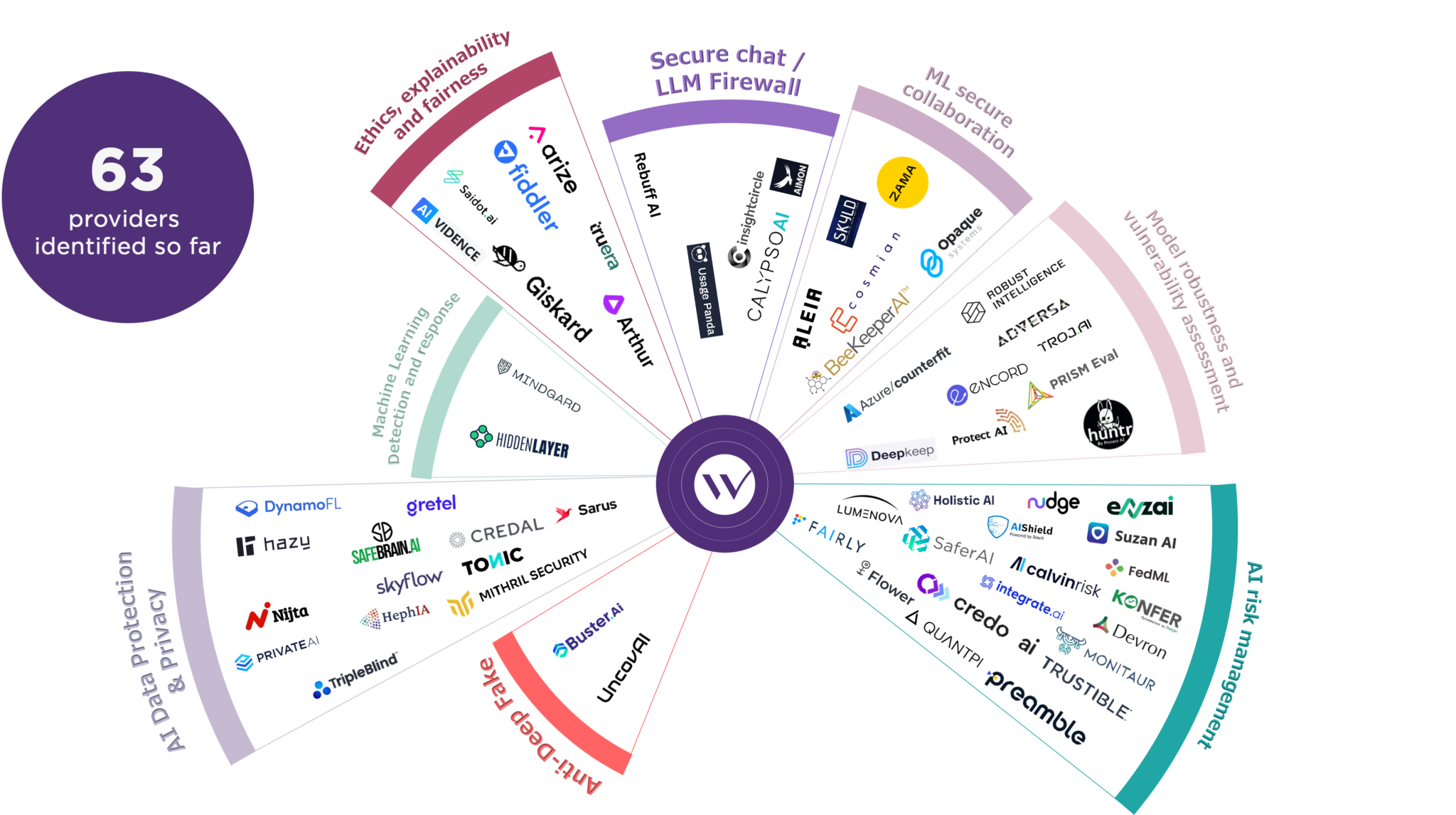AI Security Solutions: A Radar to Discover This New Market
Why is AI security different?
Unlike traditional IT systems, AI relies on statistical decision-making, introducing unique challenges in cybersecurity. These include risks such as poisoning, where attackers manipulate data or models to alter an AI’s decision-making; oracle attacks, which compromise models through careful analysis of inputs and outputs; and evasion, where small perturbations in inputs cause significant errors in outputs.
Moreover, the emergence of AI-focused regulations and standards such as the AI Act, and guidelines from OWASP (Open Web Application Security Project) and NIST (National Institute of Standards and Technology), highlights the need for specialized security solutions.
In response to these new threats and requirements, a new breed of cybersecurity measures must be applied. These measures could be built internally if you have sufficient resources and expertise but it’s rarely the case. Therefore a new market is emerging for solutions dedicated to AI systems security. These promise to offer businesses time-saving tools and access to expertise beyond their internal capabilities, ensuring compliance and enhancing security in the AI-driven landscape.
Wavestone’s AI Security Solutions Radar offers a visual panorama of market-leading cybersecurity solutions for AI. Our team analyzed the market through open source scouting and closed communities discussions and we directly interviewed vendors.
8 Categories of AI Security Solutions
This hands-on approach allowed us to establish eight categories of cybersecurity offers:
- AI Data Protection & Privacy – Keeping AI related data private and compliant
- Ethics Explainability & Fairness – Making sure AI decisions are fair, transparent, and effective
- AI Risk Management – Providing a complete overview and control of AI risks
- Secure Chat/Large Language Models (LLM) Firewall – Keeping data and models confidential when used by others
- Machine Learning Secure Collaboration – Adding security checks to protect Machine Learning models from attacks and prevent unexpected actions.
- Machine Learning Detection & Response (MDLR) – Offering comprehensive protection, including detecting changes in models and data.
- Anti-Deep Fake – Countering a growing societal concern with an increasingly negative business impact on companies.
- Model Robustness & Vulnerability Assessment – Relying on AI to provide the assessment for a diversity of exploitable vulnerabilities.
Each category gathers solutions addressing comparable security needs and requiring similar technical specifications.
AI Security: A Dynamic Market
Many companies have decided to embrace the potential in the AI Security market. Many companies have decided to embrace the potential in the AI Security market with different market approaches.
66%
entered the market as an AI security pure player
17%
enhanced their security offer with AI security
17%
brought a security feature to their list of AI services and offers
Key Market Trends in AI Security Solutions
We used the AI Security Radar’s unique overview to intersect critical factors:
- Client AI use-case needs.
- Ability to create the AI security technology.
This analysis pinpointed three main market trends for AI security offers.
Today’s Most Available Tooling: Governance and Compliance Solutions
Companies need to meet increasing regulations and want clear oversight of AI-related risks. They are turning to compliance and governance tools. These tools requires a limited R&D requirements, leading to rapid market growth.
Radar categories covered are:
- AI Data Protection & Privacy
- Ethics Explainability & Fairness
- AI Risk Management
Next in Line: Securing Chatbot and Machine Learning Collaborative Systems
Chatbots and Machine Learning (ML) collaborative systems have been two of the faster-expanding aspects of AI adoption by businesses and the most thought-after use-cases. These technologies often expose AI systems to many users or involve sharing data or models with external partners, raising the need for security. Yet, at this stage, many companies are still using basic security measures they set up themselves, rather than seeking more comprehensive solutions from the market.
Radar categories covered are:
- Secure Chat/Large Language Models (LLM) Firewall
- Machine Learning Secure Collaboration
Future Needs: Awaiting AI Maturity
Some categories are really important to manage risks seen as critical by our clients. However, the technical challenge to build a product means a low number of solutions or services today. As they are critical as companies gain in maturity in their AI security practices and policies, many research projects are currently being led either by the big names on the market or by independent laboratories. We should therefore see the arrival of new products in the coming months.
Radar categories covered are:
- Machine Learning Detection & Response
- Anti-Deep Fake
- Model Robustness & Vulnerability Assessment
What Next for AI Security Solutions?
Market Evolution: AI Security's Path to Maturity and Standardization
We anticipate the AI security market to foster consolidation, enhanced customer maturity, and regulatory alignment.
- Increased funding and strategic partnerships among AI security firms and research institutions will support the development of sophisticated solutions.
- Customer maturity will drive AI security providers to tailor and enhance their solutions.
- Emerging legal standards, rooted in current regulations, will guide the market towards uniformity, offering clearer insights into its trajectory.
Our Vision for Your AI Journey: Towards a Trustworthy AI
The imperative for both clients and providers is to prioritize the creation of dependable AI systems through targeted, case-specific initiatives – until the market becomes more defined.
- Today’s priority is trust. Amidst the rush to adopt AI, the paramount question is ensuring the reliability and integrity of these systems.
- The time is just right for AI security. While AI’s use for security may not yet be mature, securing AI use-cases and related infrastructures is critical now more than ever, as their business needs scales up.
- We recommend tailored investments on a project-by-project basis, rather than broad commitments to a single platform. Keep in mind that the AI security sector is expected to undergo rapid changes with new entrants, mergers, and collaborations.
AI Security Radar: Navigating a Dynamic Future
Thank you for reading the inaugural version of Wavestone’s AI Security Radar.
This is just the beginning. This tool is designed to adapt and grow alongside the ever-evolving market of AI security.
As we discover and engage with new solution providers, they will be integrated to the radar. Additionally, we are committed to enriching this tool with in-depth analyses of each category, offering deeper insights into their technical capabilities and methodologies.
Stay tuned for the next AI security solutions!
Want to talk about the AI Security Radar?
Whether you want to discuss what tool might be suited to your needs or have your solution be considered for the radar:
AI Security Radar Methodology
- Our team identified AI security solutions through open source scouting and closed communities discussions over the last 6 months. Among these, we met illustrative vendors for interviews, including technical demonstrations.
- Categories were established based on the needs addressed by security solutions.
- The maturity level of each category was defined by considering the average lifespan of its companies and the types of clients they serve.
- To maintain a clear and focused radar, we placed companies into one category, even if their solutions cover multiple areas.




